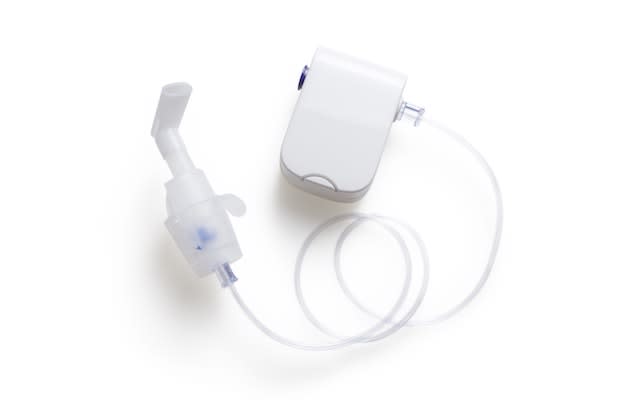Table of Contents
III. Long-term Asthma Inhalers
What is Asthma?
Asthma is a chronic breathing condition that affects over 25 million people in the United States. [1] Asthma occurs when your airways become inflamed and swell. This reduces the amount of air that can pass through the airways, causing breathing difficulties as well as chest tightness, coughing, and wheezing.
Asthma can vary greatly between patients. Patients with mild asthma can go long periods of time without showing symptoms or without a flare-up of their condition. However, patients with moderate or severe asthma may have regular asthma attacks, even when treating their condition with medications. [2]
Asthma is the most chronic disease in children and affects approximately 8.3% of children. [3] Most children that develop asthma show symptoms before they turn five. [4] However, this condition affects people of all ages and can develop at any point in your life.

a. What Causes Asthma?
It is not known what exactly causes asthma. However, the World Health Organization (WHO) believes that is caused equally by genetic and environmental factors. [5] Many asthma patients have close relatives who also have the condition. However, it is possible to develop asthma without having a family history of the condition.
When asthma is developed during adulthood, it is often a result of environmental factors such as air quality and pollution. Many allergens such as grass, pollen, animal dander, and dust mites are found in the air around us. Around 80 percent of asthma patients are allergic to these or other airborne substances. [6]
Diagnosing Asthma
In order to diagnose asthma, doctors will ask about your medical history and will perform certain physical tests. Asthma symptoms are very similar to the symptoms of COPD (chronic obstructive pulmonary disease). Some physical exams are performed to rule out the possibility of other breathing conditions such as COPD.
There are several different breathing tests that may be performed to diagnose asthma. Common asthma tests include:
Spirometry Test: Spirometry tests involve checking how quickly and how much air a patient can exhale. This helps doctors to estimate how narrow the patient’s bronchial tubes may be.
Peak Flow Test: A peak flow test uses a device to measure how forcefully you can exhale.
Imaging Tests: Imaging tests such as X-rays can help to identify internal causes of breathing disorders.
Methacholine Challenge: This involves inhaling a common asthma trigger. If you react to methacholine, then it is likely that you have asthma. [7]

Long-term Asthma Inhalers
There is no known cure for asthma. However, there are many medications available that can help control the symptoms of asthma. Control medications are long-term inhalers that are used every day. Long-term inhalers come in several forms.
a. Bronchodilators
Bronchodilators are a commonly prescribed long-term asthma inhaler. Common bronchodilators include Spiriva (tiotropium) and Atrovent (ipratropium). Bronchodilators work by relaxing the muscles in the lungs and widening the airways. Bronchodilators also improve breathing by clearing mucus out of the lungs. Some bronchodilators may also be prescribed as short-term relief inhalers. There are three main types of bronchodilator inhalers: anticholinergics, beta-2 agonists, and theophylline. Beta-2 agonists are typically prescribed for asthma. [8]
b. Corticosteroid Inhalers
Corticosteroid inhalers are another form of long-term medications. When taken regularly, corticosteroids are considered to be the most effective long-term asthma control medication. [9] Corticosteroids are potent, anti-inflammatory drugs that are used to treat several inflammatory conditions. Common corticosteroid inhalers include Flovent (fluticasone) and Pulmicort (budesonide).
These inhalers work by reducing inflammation and swelling in order to widen the airways. This helps make breathing easier. Corticosteroids take a long time to work, so should not be used as a quick-relief inhaler. It may take several weeks for corticosteroids to relieve asthma symptoms, but the longer they are used, the less often you will need to use a quick-relief inhaler.
Corticosteroids can also be taken as an oral tablet or in a liquid form. However, they are usually prescribed in an inhaler form as the medication goes directly to the lungs. [9]
c. Combination Inhalers
Combination inhalers combine two or medications. Usually, combination asthma inhalers combine a bronchodilator and a corticosteroid. However, some combination inhalers combine two bronchodilator medications. Commonly prescribed combination inhalers include Advair (fluticasone and salmeterol) and Symbicort (budesonide and formoterol). Combination inhalers give the benefits of both bronchodilators and corticosteroids by opening your airways and reducing inflammation. [10]
In addition to using a long-term control inhaler, quick-relief inhalers (or ‘rescue’ inhalers) are also commonly used to treat asthma. Unlike the inhalers above, quick-relief inhalers are not taken daily on a schedule. Inhalers such as Ventolin (albuterol) are used to relieve an asthma attack or sudden shortness of breath. Quick-relief inhalers may also be taken as a precaution before exercise. When asthma is controlled properly with a long-term inhaler, quick-relief inhalers should only be used infrequently. Quick-relief inhalers are short-acting bronchodilators. These inhalers work by quickly opening up airways. [11] The content in this article is intended for informational purposes only. This website does not provide medical advice. In all circumstances, you should always seek the advice of your physician and/or other qualified health professionals(s) for drug, medical condition, or treatment advice. The content provided on this website is not a substitute for professional medical advice, diagnosis or treatment.
Quick-Relief Inhalers
